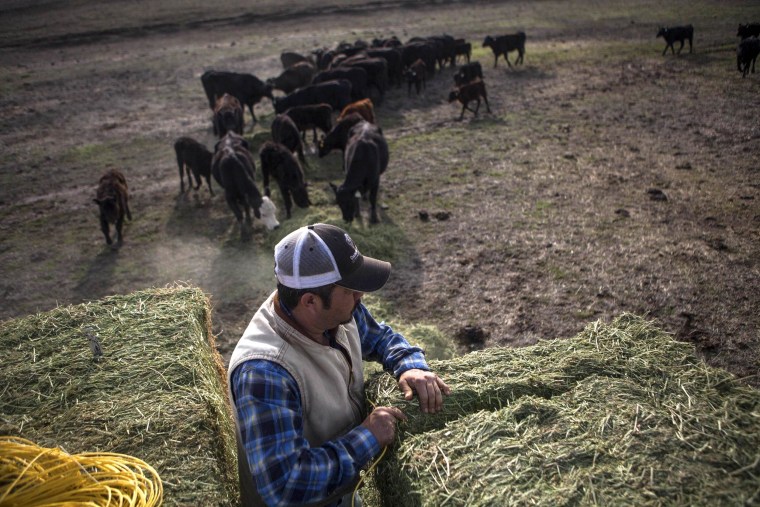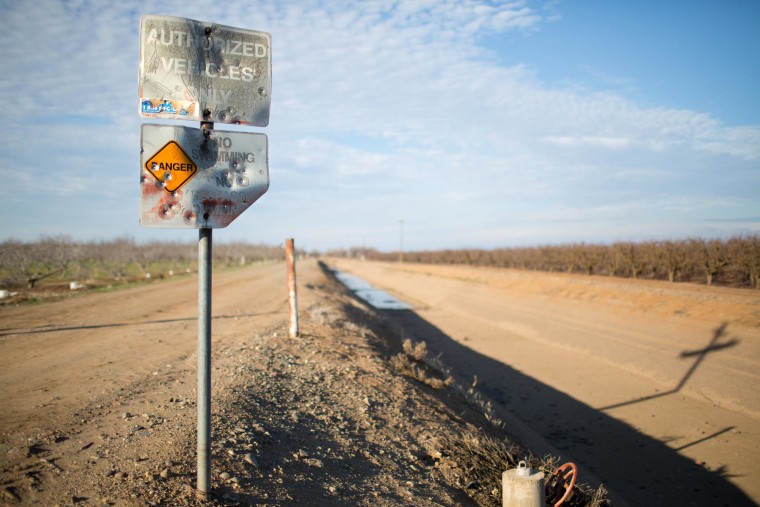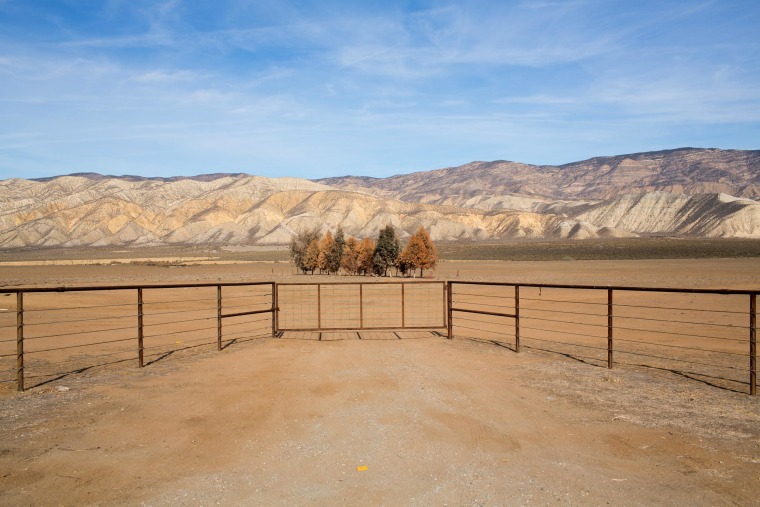As California and other western states face what some scientists fear could be a prolonged drought amplified by global warming, water experts say there's simply no way to predict how long the dry spell will last.
The best thing to do, they said, is to prepare for the worst and hope for rain. It wouldn't be the first time California soil went parched for a long stretch. Tree growth rings in the region show evidence of prolonged periods of aridity in the past.
"To know that we are going into another pattern like that, that we could expect this drought to persist for 10 to 15 years is really, really, really hard to say," Brian Fuchs, a climatologist with the National Drought Mitigation Center in Lincoln, Neb., told NBC News. "There is really nothing in our forecasting models that are being looked at that would suggest that we would even have the ability to do that."
"It is hard to know how bad this drought is going to get … but the climate is changing. We know that droughts are becoming more frequent and more intense, so we need to begin thinking about the possibility of longer, more intense droughts in the future."
And even if a new mega-drought is here, he added, no one knows if the impacts would be as devastating as the droughts "700 years ago that moved entire societies out of regions," Fuchs said. "Are we able to offset some of that impact because of the developed water systems and technology? That's even a tough question to ask."
But variations of the question are nevertheless being asked across the state where, at last count, 10 communities have less than 60 days of water, forest fires flare up almost daily, water deliveries to 750,000 acres of farmland and 25 million people have been halted, cattle are starving on wilted rangelands, and homeowners are drilling thousands of wells to suck water from aquifers they only hope won't go dry.
"It is hard to know how bad this drought is going to get … but the climate is changing. We know that droughts are becoming more frequent and more intense, so we need to begin thinking about the possibility of longer, more intense droughts in the future," Heather Cooley, co-director of the water program at the Pacific Institute, an Oakland-based environmental think tank, told NBC News.
Land fallowed, cattle sold
The impact to the state's $45 billion agriculture industry has already been severe. An estimated 500,000 acres of farmland sits unplanted due to water shortages, a number that could nearly double if the drought extends into 2015, according to Doug Parker, the director of the California Institute of Water Resources housed at the University of California's Division of Agriculture and Natural Resources in Oakland.
Fallowed fields translate to high rates of unemployed farmworkers who fall back on social services such as food assistance programs.
"In the long term, it could change some of the cropping patterns in California, especially for the animal industry," Parker told NBC News, explaining that the economics of raising and tending livestock hinges on locally-grown feed. "Without water to grow it, you really end up just having to sell off animals." Much of the state's beef cattle, for example, roam unirrigated rangelands that are parched.

To deal with the drought, farmers that can will fallow their land; others will revert to pumping groundwater. "It will be harder for farmers who have permanent crops — trees, nuts, orchards," noted Cooley, whose organization has advocated increased use of water efficient technology on farms such as drip irrigation systems as a way to save millions of acre feet of water a year.
The adoption of such technology has recently increased and may accelerate if this drought persists, especially if farmers with senior water rights lose their full annual allocations, which may happen this year. "That can be a pretty strong incentive to use the water that you have more efficiently," she said.
Diversity helps
Water problems are less acute, for now, in most of the state's largest cities, which operate with drought contingency plans to deal with dry years. The strategy typically involves tapping diverse sources of water — local and imported surface water, reserves stored in reservoirs and groundwater aquifers, wastewater recycling, even desalination along with a heavy dose of pleas for conservation.
"Generally speaking, the agencies that are currently facing the most severe challenges are those that have a limited number of surface water supplies and don't have easy access to groundwater as a backup," Gregory Weber, the executive director of the California Urban Water Conservation Council, told NBC News.
"The forecasts are not great for this year and even the longer term ones are showing a higher probability than normal of drought."
What makes this drought particularly worrying, he noted, is the unique combination of multiple years of scant precipitation combined with historically low water reserves in storage. The Metropolitan Water District of Los Angeles, which serves as a wholesaler of imported water to Southern California, has reported sufficient water in reserves for another year due to conservation efforts. After that, the situation is less certain.
"Drought is an opportunity for people to realize that if it weren't for the conservation they were doing all the time, things would be an awful lot worse," Weber said. "And it gives them new incentive to try even harder."
'Simply not a lot of water'
Natural ecosystems, too, are reeling from drought. Low water levels in rivers, for example, are preventing young salmon from swimming toward the sea while adult salmon are unable to get through estuaries to the main stem of rivers to spawn, according to Brian Stranko, the California water resources director for The Nature Conservancy, an environmental advocacy group.
"We can try to take as many emergency actions as we can to help our farms, our fish, our wildlife, our communities, but we really don't have a lot of options," he told NBC News. "There is simply not a lot of water. We should really use this unfortunate event as an opportunity to think about how to prepare for the next drought and the one after that. We didn't do that in the last drought, we need to do it now."

At the top of The Nature Conservancy's agenda is promoting responsible management of groundwater resources, which are currently unregulated and unmonitored across much of California.
Many cities and farms turn to groundwater when surface water is in short supply, such as now, but they do so without accounting for how much is there, how much is replenished during wet years, or how much is held in reserve. "We just continue to pump," Stranko said. "Therefore we are depleting our overall water supply."
The climate factor
The long-term water woes in California are heightened by global climate change, which is expected to "increase the intensity and frequency of drought in drought prone areas," Ann Chan, the deputy secretary for climate and energy with the California Natural Resources Agency in Sacramento, told NBC News.
A key impact from long-term climate change will be the loss of water stored as snow in the mountains as winters warm and more precipitation falls as rain. "We know that we are going to have to come up with new storage solutions for water," she noted.
Those solutions will be added to what are already among the most managed hydrologic systems in the world, according to Betsy Otto, the water initiative director for the World Resources Institute in Washington.
"They were designed, in many instances, for a certain kind of hydrologic record or history, which included variability, but it is hard projecting forward to know how much more extreme will those variations become and what that will mean for the management of those systems," she told NBC News.
For now, many water experts are focused on the evolution of the current drought. "The forecasts," noted Parker with the California Institute of Water Resources, "are not great for this year and even the longer term ones are showing a higher probability than normal of drought."
